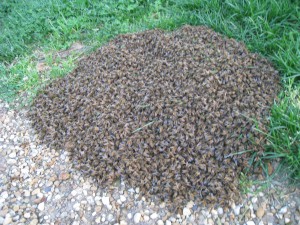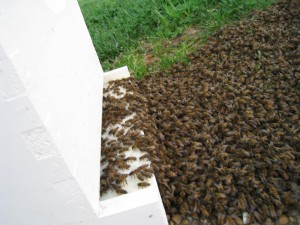Since before I picked up my first two hives, I have been dreaming about the day that I would find and collect a swarm of bees somewhere in the Richmond, Virginia area. In all honesty, I figured it would most likely be down in Charles City, where I grew up, as a lot of those folks know that I am keeping bees and looking for swarms. Regardless, I figured that it was a slim chance at the moment, as the word is only starting to spread.
 So, when I received a call at 5:45 PM this afternoon about a ‘swarm of bees’, I was elated. I cannot remember being so excited (well, I was more excited a few months ago when I found out that my wife was pregnant – but outside of that, nothing comes to mind.) I ran into the house to check my notes. Despite all of the reading and research that I had done, my mind went empty when my wife said ‘swarm’ and I couldn’t remember the first thing that I needed to do! Fortunately, I have been keeping notes in this blog and was able to get my ducks in a row and strike out for Charles City (the swarm was actually located at a plantation nearby, called Westover Plantation – a grand, old home on the James River where some good friends of my parents live.)
So, when I received a call at 5:45 PM this afternoon about a ‘swarm of bees’, I was elated. I cannot remember being so excited (well, I was more excited a few months ago when I found out that my wife was pregnant – but outside of that, nothing comes to mind.) I ran into the house to check my notes. Despite all of the reading and research that I had done, my mind went empty when my wife said ‘swarm’ and I couldn’t remember the first thing that I needed to do! Fortunately, I have been keeping notes in this blog and was able to get my ducks in a row and strike out for Charles City (the swarm was actually located at a plantation nearby, called Westover Plantation – a grand, old home on the James River where some good friends of my parents live.)
So, here we are, headed out to Charles City, about 15 minutes from the house, when my wife casually mentions that Mushi (one of the owners of the home) had called another beekeeper before me, but just left a message. This was a real blow. Was that other guy (or gal) already out there getting those bees?! I had a hard time not putting the pedal to the medal at this point.Fortunately, when I arrived there was no other beekeeper in sight, so it was time to go into action!
Now, back to the swarm. When my wife relayed the message to me, she mentioned something about a ‘swarm of bees on the ground.’ I didn’t question her, but figured that she (or the initiator of the message) had gotten it wrong. Bees swarm on branches or some other obstacle they can hang on. They do not swarm ‘on the ground’. Per usual, the bees proved me wrong once again. Here was a pile of bees, smack dab on the ground at the base of a tremendous tree (perhaps 200 feet high.) Way up in the tree (well, about 50′ up), you could see a hole with bees going to and fro. But, here on the ground was a mass of bees (and hopefully a queen!) What in the world was I to do now? I had tons of notes, but not one of them mentioned ‘how to get them on the ground.’ In all cases, you were getting them off of an object, typically a tree. Life is never easy…
After thinking for a second, I decided to call Tom Fifer, my bee expert (well, he’s the expert that I bug with all of my crazy questions.) As fate would have it, he was out! On a whim, I mentioned my delimma to Mrs. Fifer and, much to my glee, she knew of a similar situation that Tom had and the solution! Put an empty hive with a couple of frames of honey on the ground near them and they will march right in! I had brought only one frame, partially full of honey (I do not have the resources that Tom has yet). There was nothing to be done but give it a go.
 I set up the Deep right by the swarm (a hair from the edge of it) and dropped my frame of honey a little to the left of center. In seconds (and I mean seconds), a couple of bees went in and then the whole band started moving in. First in four’s and five’s, then by the droves. As I watched, you could see a few of them mill about on the landing deck and fan to send the sent to the rest. As a mass, the whole thing started moving towards the hive. It was truly amazing. An event of nature that few folks see, I am sure. I will never forget it.
I set up the Deep right by the swarm (a hair from the edge of it) and dropped my frame of honey a little to the left of center. In seconds (and I mean seconds), a couple of bees went in and then the whole band started moving in. First in four’s and five’s, then by the droves. As I watched, you could see a few of them mill about on the landing deck and fan to send the sent to the rest. As a mass, the whole thing started moving towards the hive. It was truly amazing. An event of nature that few folks see, I am sure. I will never forget it.
At this point, I had an engagement with my wife at a friend’s house, so we skedaddled, with the intent of returning after dark to get my new hive of bees. You’d think I would learn. When we returned, around 9:30 PM, two-thirds or more of the bees were in the hive. But, a good mass of them was still outside of the hive, on the ground nearby! My bee luck never fails. I have no idea what to do now, but will go back out tomorrow morning and hope that they have gone back in by then. If they have not, I might take an empty deep and place it on top of them, with the deep of frames placed on top of that. I considered trying to scoop them up when I found them after dark, but decided that I would try to let nature take its course.
Why are there two sets of bees? If the queen is in the hive, the other bees should have joined her! If the queen is outside, why didn’t all of the bees in the hive go back out to her? These little critters continue to throw me curve balls.
The worst thing about this is that it will get down into the low 40’s tonight. I hope the ones outside can survive.

Reader Comments
We had 2 swarms last spring in our yard and both were on the ground and after a few days then moved to the trees…
we just got bees this week and now they are on the ground by the hive… I suppose the queen is under them.is the hive too hot? what shall we do?
The queen must be on the ground if all of your bees left the hive. I would try to spot her and gently scoop her up and put her back in the hive.
The European Honey Bee with which we grew up does not swarm on the ground. When you find a swarm on the ground (as pictured), rest assured that it has been Africanized. They will not become aggressive until they have honey and young to protect, which should be several weeks. I recommend that you destroy the hive right away, and get a new colony from a reputable bee keeper. A reputable bee keeper will no longer take a colony from the wild as this could expose his bees to colony collapse disorder in addition to the possibility of having an Africanized colony.
Master Gardener, Cooperative Extension Service, Orange County FL
Judy Lee’s comments are probably valid to the South, especially in Florida where the African strain is rampant. But, I do not believe it applies to bees in Virginia and areas to the north. To begin with, that swarm has become a very productive and partially gentle hive. Secondly, after this posting, I spoke with several beekeepers in our area that have seen plenty of swarms hit the ground, as far back as the 50’s, when no African bees were even in Florida, much less in Virginia. They attribute this behavior to the first swarm cast sometimes having a Queen that is a bit big to fly very far.
Regardless, I also have a different bent on the African Honey Bee then most (it is probably a controversial view.) I believe that this gene pool is a good resource that will prove to be a boon to the bees in America in the future. This bee has many desirable traits (a resistance to some of the problems that we currently have with the European bee) that should someday assist the bees of America. They pose a real danger down South – anyone finding any swarm (on the ground or otherwise) in the Florida or Texas states should contact a professional immediately.
Thank you Jones, We love working our gentle wild bees with a hint of AHB. I encounter Swarms mixed of all races which end up on the ground when blown down by wind. Any bee swarm hanging in an exposed ball could fall with wind, also Sometimes queens have a difficult time leaving the yard. After the swarm ball drops, They will climb or enter any structure available. If there is no structure, they will form a pizza shape. Any swarm can do this especially those Italian-Americans.
Same thing just happened to me yesterday! Got a call from a lady inthe greater Toronto area (I live in Ontario) and even though it’s only April the weather has been nuts enough that there was a swarm…on the ground…
I was a little confused by the behaviour but was game to help them out. The temp had dropped the previous night to 0 C, and there were dead bees clumped around the edges of the swarm, so sad. It knocked their numbers down by a 3rd, and it was not a big swarm to begin with. They fit nicely in a nuc box but I did not see the queen. Am hoping for the best. I doubt these ladies are Africanized up here but I agree with genetic diversity, and a bee is a bee is a bee. We’ve gotten reports of presticide kills in Ont this year so any help we can give ON EARTH DAY TOO! is almost like a moral obligation for me. Wish us all luck!!
Good luck, Jessica!
Hope it works out for you and the bees! I have come to believe that they end up on the ground whenever the queen has not ‘trimmed’ down enough to fly well (they reduce her feed the week before they swarm, so she is better able to fly, but I think some of them do not do a good job of it!)